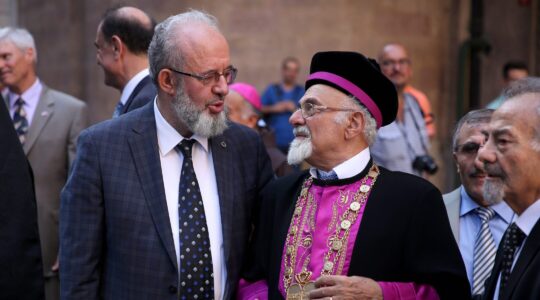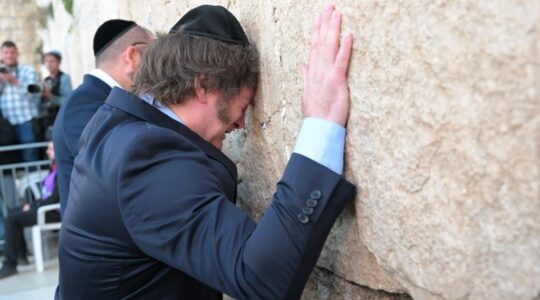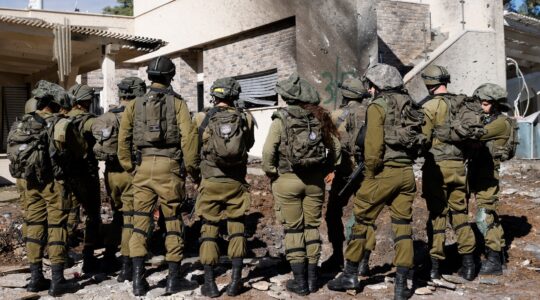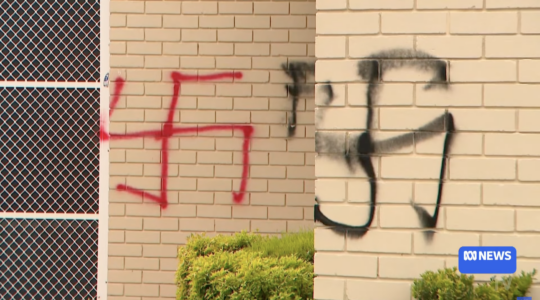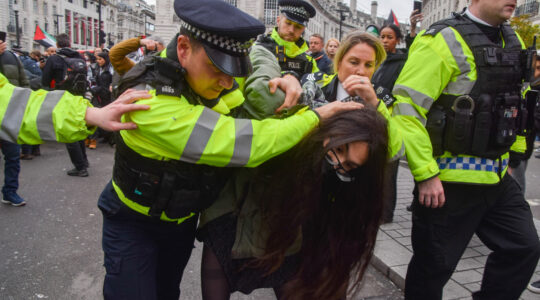
Heinz Bischitz poses next to a photograph of himself as a child in prewar Austria, part of a collection of photos now on display at the Linz Wissensturm cultural center, Oct. 26, 2009. (Ben Harris)
EUROPE RECKONS WITH ITS PAST
LINZ, Austria (JTA) — They shuffled along the uneven cobblestones on Schwedenplatz, a group of elderly Holocaust survivors in Vienna bound for a bus waiting to ferry them two hours west to Linz, Austria’s third-largest city.
The occasion was the opening Monday of a photo exhibition at the Linz Wissensturm cultural center depicting Jewish life in prewar Europe. It’s part of a much larger collection of oral histories complied by Centropa, a Vienna-based nonprofit dedicated to preserving Jewish memory that has interviewed 1,262 elderly Jews and digitized more than 20,000 family snapshots over the past nine years. The exhibition runs until Dec. 11.
A procession of public figures attended the opening, including the president of the Austrian parliament and the governor of the state of Upper Austria, of which Linz is the capital.
Referring to her government’s support of Centropa, Barbara Prammer, the parliament’s president and a Linz native, told JTA, “We have to do it. It’s our responsibility.”
Prammer’s view is fairly common today among mainstream politicians in Europe, where declarations of responsibility to remember the murder of Europe’s Jews and educate younger generations about the evils of the past are generally uncontroversial.
These days, interest appears to be growing not only in memorializing the victims but in remembering the vibrant Jewish societies that were incinerated by the Holocaust. Like Daniel Libeskind’s Jewish Museum in Berlin, the Centropa exhibition focuses not just on how Jews died in Europe but on how they lived.
“What had not been done was to go to these same people and ask them to paint a picture of how these people lived,” said Centropa founder and director Edward Serotta, explaining the motivation for his group’s creation.
The exhibit in Linz is the first to cull material from the 15 countries where Centropa operates.
Among the bus riders from Vienna was Heinz Bischitz, the son of an amateur photographer whose photo of Bischitz as a young boy standing in the snow is among the 200 or so on display in Linz. A few panels down is a photo of Jewish Hungarian soldiers gathered in uniform in the Dohany Street synagogue in Budapest. Others show children at play, mothers and fathers by the seashore, shopkeepers posing proudly with their wares and Jewish soldiers heading off to war.
“Most of the time when they hear about Jews in the 20th century, it’s all about Holocaust, Holocaust, Holocaust,” said Andreas Heider, a high school teacher in Linz whose students participate in educational programs organized by Centropa. “This is something different. It’s about Jewish life from several countries in Europe, and that’s something new and interesting for the students.”
Of course, the subtext behind the photos is the understanding that the world depicted in them was destroyed forever. That gives the images, noteworthy mainly for their quotidian depictions of ordinary life, a particularly potent kind of power.
“Of course the program is about the Holocaust,” Serotta said, “and we pretend that it’s not.”
A ceremony Monday at the Wissenstrum featured the screening of a short film assembled by Centropa staffers from the family photographs of Kurt Brodmann. In the film, Brodmann narrates the story of his father, a well-known actor who fell in love with his mother after spotting her in the front row of one of his performances.
Afterward, the gathered politicians took turns asserting their dedication to the preservation of Jewish memory and its importance for modern Austria.
“If we don’t learn these lessons, then history can repeat itself,” Upper Austria Gov. Josef Puhringer said. “This is why an exhibition like this one is an investment in the future.”
On the bus back to Vienna, Serotta was fired up.
“When you saw these hard-edge politicians stand up and get emotionally shaken after watching what is just a sweet story that you would hear sitting on the sofa next to your Jewish grandmother, it really does mean that Centropa is creating very new ways of looking at the Holocaust and Jewish history,” he said.
But several of the survivors were less certain of the significance of what they had seen.
“It’s a nice feeling that the world will ‘remember’ us,” Bischitz said, making air quotes with his fingers.
Bischitz fled Vienna for Budapest as a child and said he is angry not at Austria, where he was never persecuted or experienced anti-Semitism, but with the Hungarian SS who deported his parents.
“I am not a patriot,” Bischitz said. “The only national anthem I hear is ‘Hatikvah’ and I feel something.”
Lilly Tauber, 82, whose photo of her grandparents’ shop in Prein an der Rax, Austria, is included in the Linz exhibition, also said she wasn’t moved by the speeches.
As a child of 12, Tauber was placed in a Kindertransport from Vienna’s Westbanhof train station and survived the war in England. She had never traveled anywhere alone before and still remembers waving goodbye to her parents on the platform. It was warm, she recalled, and her mother was wearing a light summer dress.
Tauber never saw either of them again.
“I can’t forget what happened 70 years ago, whatever they say,” she said. “I’m sure some [politicians] mean it honestly. But with some people, I’m not so sure if they mean it or if they say it’s enough talking about it already.”
JTA has documented Jewish history in real-time for over a century. Keep our journalism strong by joining us in supporting independent, award-winning reporting.
